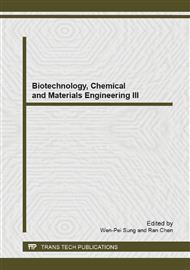p.269
p.273
p.277
p.283
p.287
p.292
p.296
p.300
p.304
Effects of Temperature and Mineralizer on In2O3 Crystals Synthesized by Hydrothermal Method
Abstract:
In ( OH ) 3, InOOH and In2O3 crystals were synthesized by hydrothermal method, using pure water, 1mol/L KOH and 5mol/L KOH as mineralizer, the fill factor of 35%, reacted at the temperature of 200°C, 250°C and 350°C respectively, and time of 24 h. The phase transformation rule of In ( OH ) 3, InOOH and In2O3 was studied in different temperatures and mineralizer, and their morphology have been analyzed. When pure water was used, temperature was 200°C , the results showed that In ( OH )3 crystalline phase was no obvious transformation and secondary crystallization, the crystal had nonspecific morphology. While temperature was 250°C and 350°C, the In ( OH ) 3 crystal transformed into InOOH. When 1 mol/L KOH and 5 mol/L KOH was used, temperature was 200°C , the In ( OH ) 3 crystal had secondary crystallization. In particular, the largest-scale crystal was about 20 μm, the smallest crystal was less than 200 nm when 5 mol/L KOH was used. InOOH crystal and a small amount of In2O3 were obtained in 250°C. When temperature reached 350°C , the In2O3 with cubic bixbyite structure was obtained, exposing the faces { 001}, { 010}, { 100} and { 101}, and the length of crystal side was more than 50 μm.
Info:
Periodical:
Pages:
287-291
Citation:
Online since:
January 2014
Authors:
Keywords:
Price:
Сopyright:
© 2014 Trans Tech Publications Ltd. All Rights Reserved
Share:
Citation:


